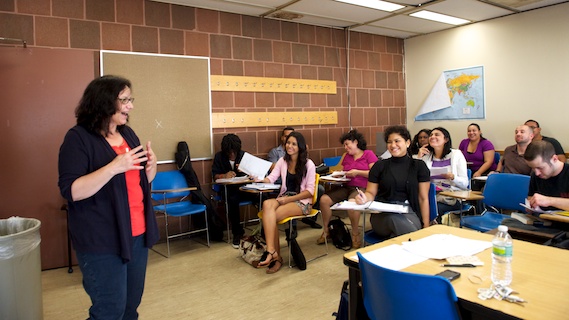
It’s the second session of Marguerite Rivas’s English 201 class, a few days before the 10-year anniversary of 9/11, and students are analyzing William H. Auden’s famous poem, “September 1, 1939,” about the invasion of Poland that led to World War II.
Using a new skill—looking up references—they learn that Auden’s “Collective Man” is not, in fact, a Marvel comic book hero, and the “Luther” he refers to is actually Martin Luther, the German philosopher, not Martin Luther King, the American civil rights leader.
These discoveries and others, unlock the poem’s meaning, and Auden’s well known line, “We must love one another or die,” triggers a spirited discussion.
“We don’t have to love each other, but we have to respect people,” says one student. “You never know when you’re going to need each other.”
Alabanza
Next, the class reads “Alabanza: In Praise of Local 100,” by contemporary New York City poet Martin Espada.
“He looked around after 9/11, and thought to himself, ‘Who is it you don’t generally hear about?’,” Professor Rivas told the class.
The poem is dedicated to the 43 kitchen workers employed at Windows on the World, a restaurant on the 106th and 107th floors of the World Trade Center’s north tower, and who perished when it fell.
Many students in the room are of Hispanic descent, and had heard the expression alabanza, which means “to praise,” called out in church.
“The cook. He had a Pirate’s cap. The guy with tattoos. The four immigrants working to send money back to their families—these are like people we might actually know,” said one young man, responding to the poem’s images.
History that was there, all along
Professor Rivas, aware that most of her class was in elementary school in 2001, took them out to BMCC’s front plaza, and pointed to the skyline a few blocks south of the college.
“If you had been a BMCC student taking an evening class on September 10, 2001,” she said, “you would have seen the Twin Towers right there, in front of you.”
Next, they quietly paid their respects at a nearby commemorative plaque honoring the eight members of the BMCC community who died on 9/11. A ring of red candles had been set out, on the ground in front of the display, and someone had placed flowers there.
In fact, two BMCC students had been working at Windows of the World—not unlike the subjects of Espada’s poem—and lost their lives in the 2001 attacks. Annette Dataram was an accountant for the restaurant, and Khamladia “Khami” Singh was an Assistant Banquet Manager.
Moving forward, with a choral invocation
“I was at school that day,” said Criseli Sandz. “My uncle worked in the World Trade Center, but he had just changed from the morning to the night shift.”
“I was in Manhattan, 42nd Street,” said Catalina Lopez. “I was with my daughter, one year old, and I pushed her stroller over the Brooklyn Bridge to get home.”
“I was on the 23rd floor at the Merrill Lynch building, right there by the Towers, delivering papers to a lawyer,” said Carmen Camache, whose three children—now ages 28, 23 and 14—have more vague memories of that day.
“I was raised in the DR [Dominican Republic],” said Lainie Marte. “We had just gotten to this country and it was very scary.”
“I was only nine years old, living with my grandmother on Staten Island,” said Erik Quinteros. “I didn’t really understand what was happening.”
In a choral reading of Espada’s poem, the students took turns with the central narrative, all joining in unison for the refrain: Alabanza. Their voices startled passersby, and they faced the skyline’s new World Trade 1, which eventually will feature an observation deck at 105 stories, and provide a new window, on the world.
STORY HIGHLIGHTS
- Poet and English Professor Marguerite Rivas teaches her students how to analyze poetry—and history.
- They read William Auden, Amy Lowell, and contemporary NYC poet Martin Espada.
- Espada’s poem, “Alabanza,” is dedicated to the kitchen workers employed at Windows on the World, and died on 9/11.

